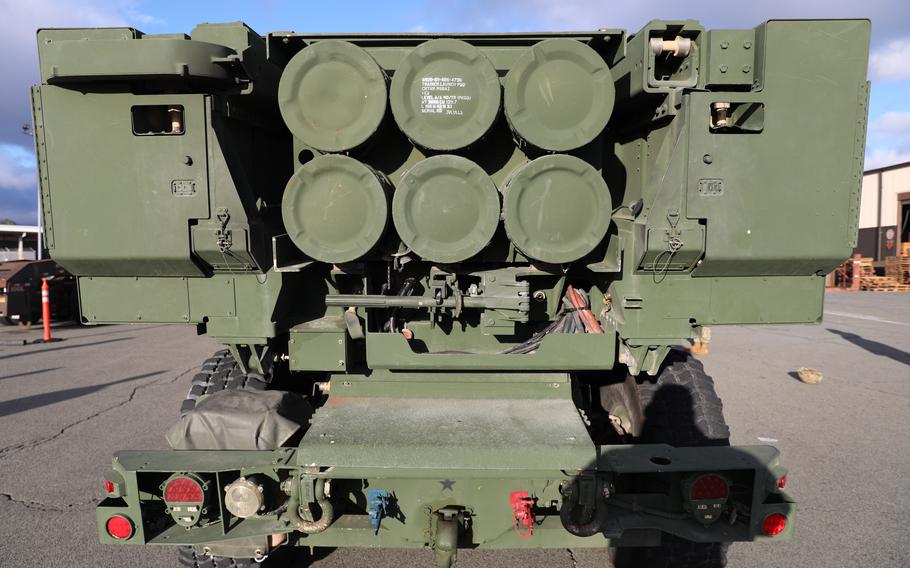
A High Mobility Artillery Rocket System, or HIMARS, one of 16 launchers slated for delivery to the Army’s 25th Infantry Division at Schofield Barracks this summer, stands at Joint Base Pearl Harbor-Hickam, Hawaii, July 14, 2025. (U.S. Army)
FORT SHAFTER, Hawaii — The 25th Infantry Division on Monday took delivery of its first three HIMARS launchers as the Army moves to increase the firing range and mobility of its Pacific ground forces.
Over the summer the division, based in Hawaii, will receive a total of 16 High Mobility Artillery Rocket System launchers as its artillery brigade divests 14 howitzers, division commander Maj. Gen. Marcus Evans told reporters during a Tuesday conference call from his headquarters at Schofield Barracks.
“HIMARS have been forward in the Pacific for quite some time,” Evans said. “I think that the big difference is now they’re going to be organic to a division. So now soldiers, instead of working behind a cannon system and towed artillery, will work with a weapon system that has increased survivability but increased operational reach with the range that they have.”
The truck-borne HIMARS is valued for its mobility and speed in deploying, firing and relocating. It can fire rockets with a range of roughly 40 miles or missiles up to 300 miles.
The addition of HIMARS to the 25th is part of the Army Transformation Initiative, by which the service will “reexamine all requirements and eliminate unnecessary ones, ruthlessly prioritize fighting formations to directly contribute to lethality, and empower leaders at echelon to make hard calls to ensure resources align with strategic objectives,” Army Secretary Dan Driscoll wrote in a May 1 letter to the force.
Army Pacific is prioritizing mobility and stealth as it considers how war might be waged in the Pacific against near-peer China.
“From a protection standpoint, when you compare the HIMARS to a piece of towed artillery, a HIMARS can shoot and move all in one organic platform very rapidly,” Evans said. “And we’re looking for the ability to quickly employ fires assets and then displace as quickly as possible to enable protection and survivability for those systems on today’s battlefield.”
Other Pacific nations have also embraced HIMARS in response to the perceived threat from China.
Australia received its first two HIMARS launchers in March, with plans to acquire up to 36. The Australian army fired its HIMARS for the first time Monday as part of the biennial Talisman Sabre exercise.
The Taipei Times reported July 6 that Taiwan’s army had established a company equipped with U.S.-supplied HIMARS.
The 25th will divest itself of eight 105mm and six 155mm howitzers to make way for HIMARS.
“We will still retain cannon capability in the formation,” Col. Daniel Von Benken, commander of the division’s artillery brigade, told reporters.
The brigade’s artillery has been “transformed and consolidated” into a single cannon battalion with two batteries of 105 mm and one battery of 155 mm howitzers, he said. A second battalion will field two HIMARS batteries, he said.
Soldiers making the transition from artillery to HIMARS undergo a three-week long course as initial preparation, Evans said.
They then return to the unit and begin training for a validation exercise in Hawaii this fall during the U.S. Army Pacific’s Joint Pacific Multinational Readiness Center combat training, he said.
Von Benken said he asks himself each morning how he can make his formation readier and deadlier.
“In this case, it’s clear that the HIMARS weapons system makes us more lethal,” he said. “At the end of the day, it extends the range of the long-range precision fires, while still retaining the capability to win in the close fight with the mobile brigade with the cannon artillery.”